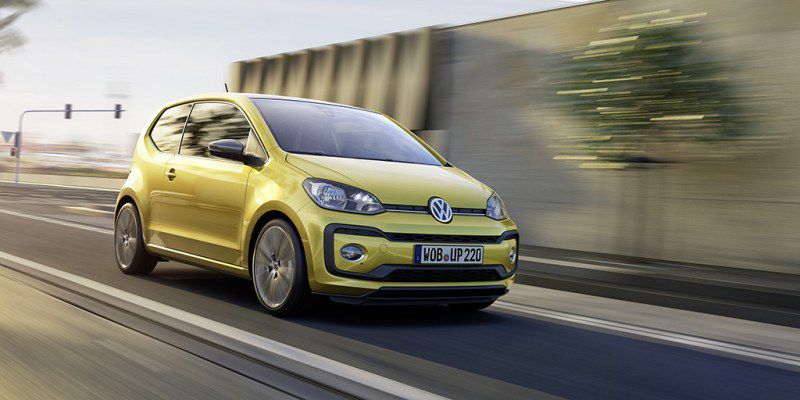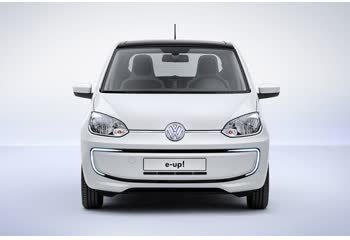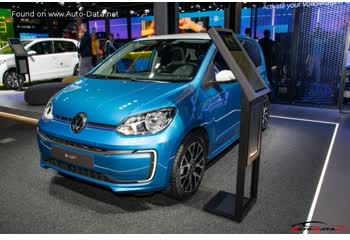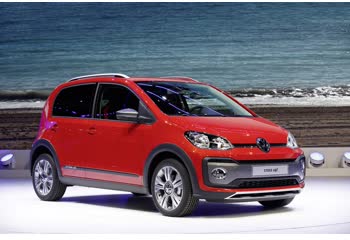Everything you need to know about specifications and performance - Volkswagen Up! 2020 - 1.0 EcoFuel (68 Hp) CNG

Overview:
What is the engine capacity of a Volkswagen Up! 2020?
The engine capacity of the Volkswagen Up! 2020 is 999 cm.
Volkswagen Up! 2020 How many horsepower?
The engine power of the Volkswagen Up! 2020 is 68 Hp.
What is the Volkswagen Up! 2020 engine?
Volkswagen Up! 2020 engine is CPGA. (Click to see other cars using the same engine)
How much gasoline does a Volkswagen Up! 2020 consume?
The Volkswagen Up! 2020 consumes 3.1 kg/100 km liters of gasoline per 100 km
General:
Brand: Volkswagen
Model: Up!
Generation: Up! (facelift 2016)
Modification (Engine): 1.0 EcoFuel (68 Hp) CNG
Start of production: 2020
End of production:
Powertrain Architecture: Internal Combustion Engine
Body type:Hatchback
Seats: 4
Doors: 3-5
Engine:
Engine systems: Start & Stop System
Power: 68 hp
Power per litre: 68.1 hp/l
Torque: 90 nm @ 3000 rpm.
Engine Model/Code:CPGA
Engine displacement: 999 cm
Number of cylinders: 3
Engine configuration: Inline
Number of valves per cylinder: 4
Fuel injection system: Multi-port manifold injection
Engine aspiration: Naturally aspirated Engine
Engine oil capacity: 3.4 l
Engine layout: Front, Transverse
Performance:
Combined fuel consumption (WLTP) (CNG): 3.8 kg/100 km
Fuel Type: Petrol / CNG
Fuel consumption (economy) - urban: 3.7 kg/100 km
Fuel consumption (economy) - extra urban: 2.7 kg/100 km
Combined fuel consumption (WLTP): 3.8 kg/100 km
Fuel consumption at Low speed (WLTP): 4.4 kg/100 km
Fuel consumption at Medium speed (WLTP): 3.5 kg/100 km
Fuel consumption at high speed (WLTP): 3.3 kg/100 km
Fuel consumption at very high speed (WLTP): 4.2 kg/100 km
Fuel consumption (economy) - urban (CNG): 3.7 kg/100 km
Fuel consumption (economy) - extra urban (CNG): 2.7 kg/100 km
Fuel consumption (economy) - combined (CNG): 3.1 kg/100 km
Fuel consumption (economy) - urban (CNG) (NEDC): 3.7 kg/100 km
Fuel consumption (economy) - extra urban (CNG) (NEDC): 2.7 kg/100 km
Fuel consumption (economy) - combined (CNG) (NEDC): 3.1 kg/100 km
Fuel consumption at Low speed (WLTP) (CNG): 4.4 kg/100 km
Fuel consumption at Medium speed (WLTP) (CNG): 3.5 kg/100 km
Fuel consumption at high speed (WLTP) (CNG): 3.3 kg/100 km
Fuel consumption at very high speed (WLTP) (CNG): 4.2 kg/100 km
Fuel consumption (economy) - combined: 3.1 kg/100 km
Emission standard: Euro 6d-ISC-Fcm
Acceleration 0 - 100 km/h: 17.6 sec
Acceleration 0 - 62 mph: 17.6 sec
Maximum speed: 165 km/h
Weight-to-power ratio: 14.6 kg/Hp, 68.3 Hp/tonne
Weight-to-torque ratio: 11.1 kg/Nm, 90.4 Nm/tonne
Acceleration 0 - 60 mph: 16.7 sec
Space:
Kerb Weight: 996 kg
Max. weight: 1380 kg
Max. roof load: 50 kg
Max load: 384 kg
Trunk (boot) space - maximum: 913 l
Trunk (boot) space - minimum: 213 l
Fuel tank capacity: 10.9 l
CNG cylinder capacity: 10 kg
dimensions:
Length: 3600 mm
Width: 1641 mm
Height: 1504 mm
wheelbase: 2407 mm
Width with mirrors folded: 1645 mm
Width including mirrors: 1910 mm
Front track: 1412-1433 mm
Rear (Back) track: 1408-1428 mm
Ride height (ground clearance): 144 mm
Minimum turning circle (turning diameter): 9.8 m
Powertrain, Suspension and Brakes:
Drivetrain Architecture: The Internal combustion Engine (ICE) drives the front wheels of the vehicle.
Drive wheel: Front wheel drive
Number of gears and type of gearbox: 5 gears, manual transmission
Front brakes: Ventilated discs
Rear brakes: Drum
Assisting systems: ABS (Anti-lock braking system)
Steering type: Steering rack and pinion
Power steering: Electric Steering
Tires size: 165/70 R14; 185/55 R15; 185/50 R16; 195/40 R17
Wheel rims size: 5J x 14; 5.5J x 15; 6J x 16; 6.5J x 17
Front suspension: Coil spring, Independent coil spring, Wishbone
Rear suspension: Semi-independent, coil Spring
See also

Other generation.
Its production began in 2013 until 2016

Other generation.
Its production began in 2019 until Now

Other generation.
Its production began in 2018 until 2019

Same engine. (CPGA).
Its production began in 2018 until 2019
Write a comment